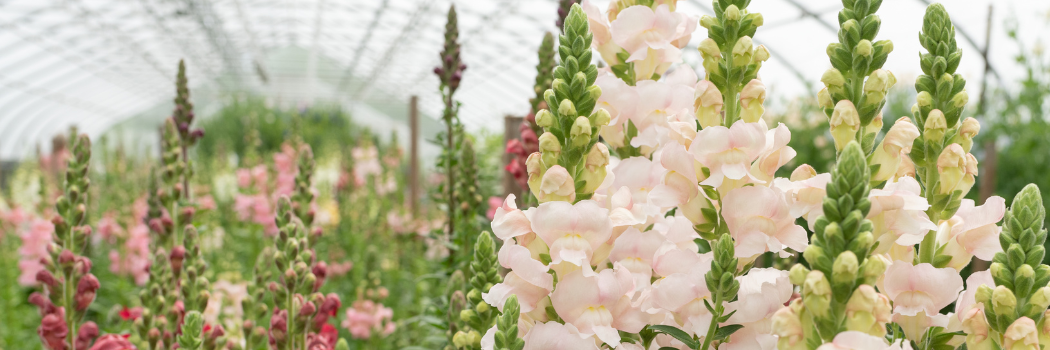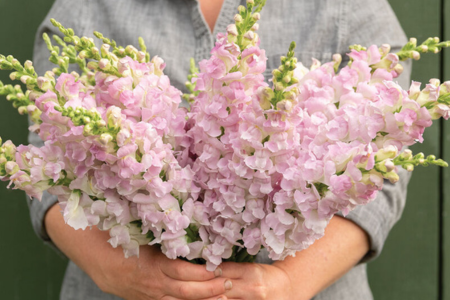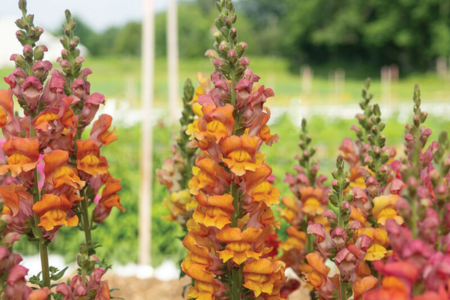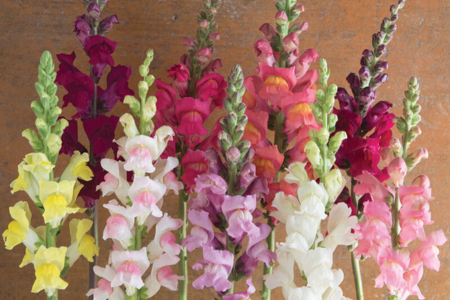- Snapdragon | Key Growing Information
- Snapdragon Production | Tech Sheet (PDF)
- Video: 'Legend Light Pink' & 'Costa Silver' Snapdragons | from Johnny's Selected Seeds
- Video: Snapdragons in Johnny's Overwinter Flowers Tunnel
- 5 Cool Flowers to Plant Now | Lisa Mason Ziegler's Secrets for Growing Hardy, Cool-Season Annuals
- Getting Started in Cut-Flowers | Top 15 Cuts
- Slow Flowers | Celebrating Fifth-Season Regional Design Elements
- Building a Better Market Bouquet: Tips, Techniques & Recipes for Flower Farmers
- Succession-Planting Flowers | Scheduling & Planning, Sowing Frequency, Recordkeeping & Recommendations
- Video: How to Build a Bouquet
- 'Double Frappe Light Pink 2' Snapdragon Variety from Johnny's
- Antibes Apricot I — Group 1 Snapdragon Variety
- 'Monaco Orange' Group 3 Snapdragons from Johnny's Selected Seeds
- 'Cannes Light Bronze III' Group 3 Snapdragons from Johnny's Selected Seeds
- Snapdragon Groups Explained
- Johnny's Edible Flower Guide | Printable 4-pp Brochure (PDF)
Snapdragon Groups Explained
What Are Snapdragon Groups?
Snapdragons are highly responsive to day length and temperature. Day length, light intensity, and temperature strongly affect the quality of blooms and stems.
Modern varieties have been bred for optimal performance under specific growing conditions and seasons.
Plant breeders assign group numbers (1-4) to snapdragon varieties to indicate the best seasonal slotting for optimal variety performance. The higher the group number, the more suited the variety is for high light, higher temperatures, and long days.
Please note: the group designations for snapdragons are not indicators of cold hardiness or frost tolerance. In general, all snapdragons prefer mild to moderate conditions and do not perform well under extreme, prolonged periods of heat. The group numbers are intended to guide seasonal slotting for optimal bloom quality and refer more to flowering speed and bloom quality under varying heat and light levels than to relative cold hardiness.
Timing Your Plantings According to Group
Plantings should be scheduled according to season, variety, and group to ensure maximum stem length and bloom quality for your climate and growing season. Refer to the chart below to see the target bloom period for each group.
You can find the group number for each variety listed in its product description on our website. Some varieties are classified with a single group and some varieties may be classified with a range of groups. For example, an individual snapdragon variety may be classified as:
- Group 1
- Groups 1–2
- Group 2
- Groups 2–3
- Group 3
- Groups 3–4
- Group 4
| Flowering Periods for Snapdragon Groups | ||||||||||||||||
|---|---|---|---|---|---|---|---|---|---|---|---|---|---|---|---|---|
| Winter | Spring | Summer | Fall | |||||||||||||
| Low light & heat | Moderate light & heat | High light & heat | Moderate light & heat | |||||||||||||
| Group 1 | ||||||||||||||||
| Group 2 | ||||||||||||||||
| Group 3 | ||||||||||||||||
| Group 4 | ||||||||||||||||
Groups 1, 1–2, and 2 (Cool Season)
Cool-season snapdragons are bred for optimal performance under short days, low light, and low temperatures. Best suited to fall, winter, or early spring production, they can be grown indoors or outdoors in mild climates.
Group 1 varieties should only be used during the coolest periods. Groups 1–2 and 2 can tolerate a bit more heat and light and are therefore more adaptable; they work well in fall and spring, as well as in winter production.
These varieties are often referred to as “energy-efficient varieties” because they grow and bloom more quickly than higher numbered groups. Under cool conditions and low light, this speed of growth is very beneficial to the flower farmer because it reduces production time while still maintaining high-quality blooms and stems. However, if grown under high light, long days and high temperatures, the plants will grow and bloom too quickly, resulting in thin, short stems and poorly formed flower spikes.
Groups 2–3 & 3 (Moderate/Warm Season)
Moderate/warm season snapdragons are bred for optimal performance under medium to long days, moderate to high light levels, and warm temperatures.
Group 3 are some of the most flexible snapdragons to grow, in terms of seasonal slotting. They are faster to grow and bloom than varieties classified as Groups 3–4 but they still produce adequate stem length and high-quality blooms under longer days, high-light and warmer temperatures. Group 3 snapdragons can be grown in the field or indoors and are well-suited for spring, summer and fall production.
Groups 3–4 & 4 (Warm Season)
Warm season snapdragons are bred for optimal performance under long days, high light levels, and warm temperatures. Groups 3–4 have a relatively slow rate of growth and delayed blooming compared to lower group numbers. This slower growth allows the plants to produce tall, sturdy stems and well-formed flowers under long days, high light, and warm temperatures. Group 3–4 varieties thrive in conditions that would cause Group 1–2 varieties to produce thin stems and poorly formed flowers on short plants. Group 3–4 snapdragons can be grown in the field or indoors and are well-suited for spring and summer production in most areas. Please note that in general, all snapdragons prefer mild to moderate conditions and do not perform well under extreme, prolonged periods of heat.





